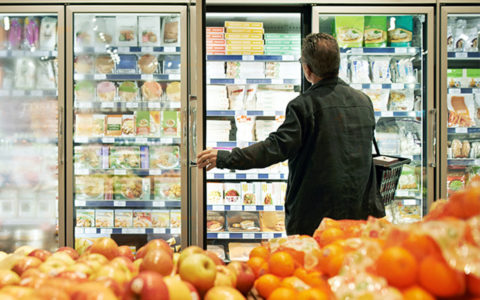Grow your bottom line with sustainable refrigeration retrofits

*On June 1, 2023 Emerson’s Climate Technologies business became a new standalone company – Copeland. Though our name has changed, we are building on more than a century of HVACR innovation and industry leadership, and Copeland continues to offer the same products, industry stewardship, and learning opportunities you’ve grown to trust. Information found on this webpage posted before June 1, 2023 may contain our old name or branding, but you can be at ease knowing it was created with the knowledge and expertise of Copeland.
Across the food retail market, supermarket operators are re-evaluating their legacy refrigeration architectures. A dynamic mix of regulatory mandates, sustainability goals and the emergence of e-commerce fulfillment models are dictating changes in the status quo of refrigeration. We recently published an article in the RSES Journal that discussed refrigeration retrofit strategies that allow retailers to meet their sustainability objectives while improving their bottom lines.

When considering refrigeration retrofits, food retailers must remember that sustainability is a two-sided coin. While reducing leaks of global warming potential (GWP) refrigerants is important for lowering direct emissions of greenhouse gases (GHGs), many supermarket operators often overlook the potential for indirect GHG emissions caused by poor system energy efficiencies.
The Environmental Protection Agency (EPA) estimates that supermarkets are the most electricity-intensive of all commercial buildings. Commercial refrigeration systems account for 40–60% of supermarket energy consumption and are by far the greatest contributor to indirect GHG emissions. Combined, direct and indirect emissions make up the true measure of sustainability, or a system’s total equivalent warming impact (TEWI).
Reduce direct emissions with lower-GWP refrigerants
The transition from high-GWP refrigerants and those with ozone depletion potential (ODP) is inevitable. Common legacy refrigerant options such as the HFC R-404A will be phased down while hydrochlorofluorocarbons (HCFCs) such as R-22 are being phased out. But this does not necessarily mean operators should immediately transition to an alternative refrigerant or embark on a complete refrigeration rebuild.
Lower-GWP A1 refrigerants, such as the hydrofluoroolefin (HFO) blend R-448A/R-449A, are available that allow end-users to retrofit their existing system, reduce GWP from direct emissions by up to 60%, and still maintain a familiar operational footprint similar to the one they have today.
For those operators currently using R-22, the transition to R-448A/R-449A is relatively straightforward and requires very few substantive architecture changes. The transition from R-404A to R-448A/R-449A is slightly more involved but can still be accomplished without significant architectural changes. R-448A/R-449A produces compressor discharge temperatures that run approximately 10–12% higher than R-404A. This may require additional compressor cooling mitigation such as head cooling fans, demand cooling modules, or a liquid or vapor injected scroll compressor. Consult your compressor OEM’s guidelines for specific retrofit procedures.
Improve system energy efficiencies
Any system retrofit or upgrade comes at a cost, so food retailers must ensure their investment delivers long-term viability and returns to their bottom line. This is where reducing indirect emissions by improving energy efficiencies plays such an important role. The U.S. Department of Energy (DOE) estimates that every dollar saved in electricity is equivalent to increasing sales by $59.
While it makes sense to undertake energy-efficiency measures in conjunction with a refrigerant transition, energy optimization best practices can — and should — be performed periodically on all systems. Before considering any retrofit options, start by performing a system assessment to determine your current performance metrics — which in many cases will deviate significantly from the system’s original commissioned baseline.
The next logical step in the energy optimization process is to enable a variable-capacity modulation strategy by either upgrading to a digitally modulated compressor or adding a variable-frequency drive (VFD) to a fixed-capacity compressor. Variable-capacity modulation provides significant system improvements, not just to energy efficiency but also to overall refrigeration system performance, reliability and lifespan. Benefits include:
-
- Precise matching of capacity to changing refrigeration loads
- Tight control over suction manifold pressures, allowing increased setpoint and energy savings
- Improved case temperature precision
- Reduced compressor cycling (on/off)
In digital compressor retrofit scenarios, we’ve demonstrated that replacing an underperforming, fixed-capacity compressor with a variable-capacity compressor can result in an additional 4% energy savings — even before activating digital modulation capabilities. And once digital modulation is activated, operators can expect an additional 12% energy savings.
Whether you’re trying to reduce your direct emissions with lower-GWP refrigerants or seeking to improve energy efficiencies and lower your indirect emissions, Emerson has compression technologies and sustainable refrigeration solutions to help you meet your specific objectives. The Copeland™ digital semi-hermetic and Copeland™ digital scroll compressors provide opportunities to transition to lower-GWP refrigerants and enable variable-capacity modulation to drive energy efficiencies.

8 proven strategies for rigorous cold chain management
by Dan Knauer | Cold Chain
Preparing for the approval and safe use of A2Ls in commercial refrigeration applications...
Protection for high-value shipments just got even better
by Alex Axelsson | Cold Chain, Transportation
We’re excited to announce the release of Copeland’s newest real-time tracker, the GO Real-Time...

Three proven strategies to prevent cargo theft
by Chris Lafferty | Cold Chain, Transportation
The over-the-road (OTR) transport industry is experiencing a surge in cargo thefts. As thieves...
The post Grow Your Bottom Line With Sustainable Refrigeration Retrofits appeared first on Copeland.